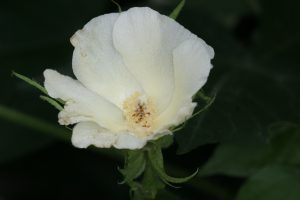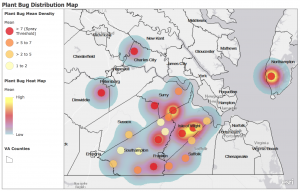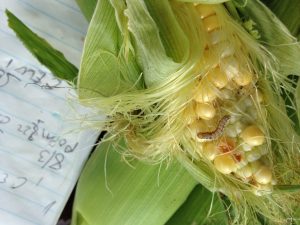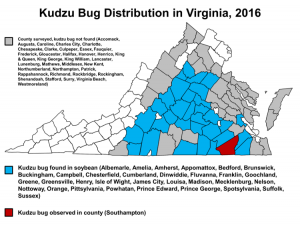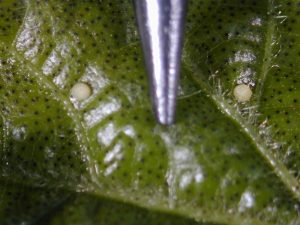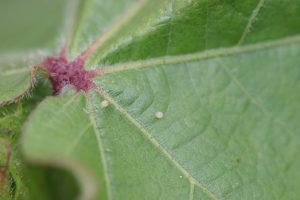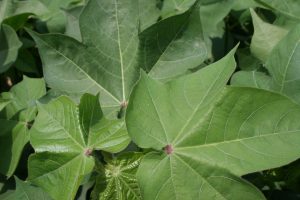The attached pdf file is a summary of Dr. Sally Taylor’s corn earworm survey in field corn; it is useful in predicting the corn earworm pressure in other crops such as soybean, cotton, and peanut as moths emerge from the corn. There are many folks to acknowledge this year (also included in the pdf file). Please see: CEW_survey_results_2017
Plant Bug Update – 4 August 2017
Twenty-three representative cotton fields in eight Virginia counties were scouted weekly for mean plant bug density. Data for the July 17th to August 3rd sampling period is represented in the distribution map below (follow link to view). Red dots on the map represent fields that have averaged at or above the spray threshold for plant bug during the sampling period. Plant bug densities for multiple fields has increased substantially since the last update in mid-July. Nineteen of the 23 sampled fields have reached the spray threshold at least once this season since sampling began in late-June. Plant bugs are present in every county sampled and are likely present in at least low numbers in all cotton growing counties in the state. Therefore, we recommend scouting your cotton fields regularly for plant bug.
The spray threshold for plant bug in Mid-Atlantic cotton is eight plant bugs (i.e., adults and nymphs) per 100 sweeps in addition to square retention below 80 percent. We recommend conducting four to eight random 25-sweep samples throughout each field. Once flowering begins, we recommend continuing sweep net sampling and also looking for dirty blooms (pictured below) or sample dime to quarter size-bolls from 25 random plants for internal feeding damage (e.g., warts, stained lint, punctures). Spray treatment may be warranted if dirty blooms and or internal damage exceeds 15 percent and plant bugs are also active in the field. Please refer to the Virginia Cotton Production Guide (pg. 23) or Pest Management Guide (sect. 4, pg. 88) for spray recommendations if spray threshold is reached.
When viewing the distribution map in full-screen mode, click on the left arrow icon to view map legend. Click on individual fields represented by colored dots on the map to view mean plant bug density for the sampling period as well as total mean density for the season. Mean plant bug densities were calculated by sampling four sweet net samples (25 sweeps per sample) and four drop cloth samples across each field. Total adults and nymphs in a single visit were totaled and averaged for each visit within the sampling period.
View full-screen distribution map
Sweet corn sampling in VA – Moth trap counts for week of July 31
Sweet corn farms are being monitored around Virginia for corn earworm and fall armyworm. Moth Trap Catch Data are being recorded by: Katlyn Catron (Montgomery Co.); Jason Cooper (Rockingham Co.); Ursula Deitch (Northampton Co.); Helene Doughty (Accomack Co. & Virginia Beach); Kenner Love (Rappahannock Co.); Laura Maxey Nay (Hanover Co.); Steve Pottorff (Carrol Co.); Stephanie Romelczyk (Westmoreland Co.); Laura Siegle (Amelia Co.); Rebekah Slabach (Halifax Co.); and Mark Sutphin (Frederick Co.).
This week we observed a general drop off in corn earworm moth catch at many locations, but still enough moth flight activity to warrant frequent spraying in many locations such as the Bridge Tunnel in Northampton County, Virginia Beach, Frederick Co., and Hanover Co. We still have not seen very many fall armyworm moths yet. For corn earworm, moth trap catch of less than 1 per night means low pest pressure and sweet corn sprays can probably be spaced 5-6 days apart during silking. However, a catch of >1 or >13 moths per night means moderate and high pest pressure, respectively, and a more frequent spray interval (every 3 or 2 days) is justified. Here are the trap catch results (moths per night) for several locations around Virginia for this week (note we do not have data for all locations):
| Week of July 31 (avg) | ||||
| Region | County | Field | CEW/night | FAW/night |
| Eastern Shore | Accomack | ESAREC – cemetery | 6.3 | 0.1 |
| Eastern Shore | Accomack | ESAREC – woods | 0.0 | NA |
| Eastern Shore | Accomack | ESAREC – sweet corn | 1.1 | 0.1 |
| Eastern Shore | Northampton | Bridge Tunnel | 15.1 | NA |
| Eastern Shore | Northampton | Capeville 1 | 0.6 | 0 |
| Eastern Shore | Northampton | Cape charles | 2.4 | NA |
| Eastern Shore | Northampton | Eastville | 2.3 | 1 |
| Eastern Shore | Northampton | Nassawaddox | 0.4 | 1 |
| Virginia Beach | Virginia Beach | Pungo 1 | 11.6 | 0.3 |
| Piedmont | Amelia | Field 1 | NA | NA |
| Piedmont | Hanover | Farm 1 | 7.8 | 0.0 |
| Piedmont | Hanover | Haynes | 6.9 | 0.0 |
| Northern Neck | Westmoreland | Field 1 | 3.0 | 0 |
| Northern Neck | Westmoreland | Field 2 | NA | NA |
| Shenandoah Valley | Rappahannock | Field 1 | 0.6 | 0.1 |
| Shenandoah Valley | Page | Field 1 | 0.2 | 0.1 |
| Shenandoah Valley | Frederick | Farm 1 | 1.4 | 0.9 |
| Shenandoah Valley | Frederick | Farm 2 | 9.1 | NA |
| Shenandoah Valley | Rockingham | Farm 1 | NA | NA |
| Shenandoah Valley | Rockingham | Farm 2 | NA | NA |
| New River Valley | Montgomery | KC | 0.1 | 0 |
| New River Valley | Montgomery | KO1 | 3.0 | 0 |
| New River Valley | Montgomery | KO2 | 1.7 | 0 |
| New River Valley | Montgomery | WF1 | 2.9 | NA |
| New River Valley | Montgomery | WF2 | 1.1 | NA |
| New River Valley | Montgomery | WF3 | 2.0 | NA |
| New River Valley | Montgomery | WS1 | 2.3 | NA |
| New River Valley | Montgomery | WS2 | 2.0 | NA |
| New River Valley | Montgomery | WS3 | 1.7 | NA |
Insect update for Aug. 3, 2017
Black light trap catches of corn earworm (aka bollworm) moths increased at most reporting stations, ranging from 5 to 58 per night this week. The pheromone traps at Suffolk also caught about 20 moths per night. Mike Arrington reported that he was seeing cotton fields (Bt and conventional) very close to egg threshold for bollworm in Suffolk and Southampton Counties.
Brown marmorated stink bugs ranged from zero to 1.7 per night. The data tables for corn earworm and BMSB are here: BLT_3_Aug_2017
Corn earworm moth survival in the cypermethrin vial tests was 36% for the week, and 40% for the seasonal average (to date). 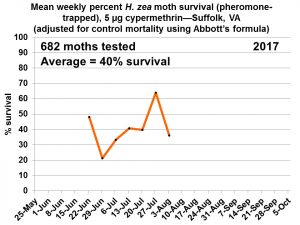
Downy mildew and anthracnose of cucurbits
This advisory is posted on behalf of Dr. David Langston. Both downy mildew and anthracnose of watermelons have been identified in the area recently. Please see the attached pdf for more details: Downy and anthracnose
Sweet corn moth trap numbers for VA counties – week of July 24, 2017
Sweet corn farms are being monitored around Virginia for the two most important pests attacking the ears, corn earworm and fall armyworm. Moth Trap Catch Data are being recorded by: Katlyn Catron (Montgomery Co.); Jason Cooper (Rockingham Co.); Ursula Deitch (Northampton Co.); Helene Doughty (Accomack Co. & Virginia Beach); Kenner Love (Rappahannock Co.); Laura Maxey Nay (Hanover Co.); Steve Pottorff (Carrol Co.); Stephanie Romelczyk (Westmoreland Co.); Laura Siegle (Amelia Co.); Rebekah Slabach (Halifax Co.); and Mark Sutphin (Frederick Co.).
This week we observed some big jumps in corn earworm moth catch at some locations such as the Bridge Tunnel in Northampton County, the ESAREC in Accomack Co., and Hanover Co. We still have not seen very many fall armyworm moths yet, only a few moths here and there in VA. For corn earworm, moth trap catch of less than 1 per night means low pest pressure and sweet corn sprays can probably be spaced 5-6 days apart during silking. However, a catch of >1 or >13 moths per night means moderate and high pest pressure, respectively, and a more frequent spray interval (every 3 or 2 days) is justified. Here are the trap catch results (moths per night) for several locations around Virginia for this week (note we do not have data for all locations):
| Week of July 24 (avg) | ||||
| Region | County | Field | CEW/night | FAW/night |
| Eastern Shore | Accomack | ESAREC – cemetery | 9.6 | 1 |
| Eastern Shore | Accomack | ESAREC – woods | 3.4 | 0 |
| Eastern Shore | Accomack | ESAREC – sweet corn | 4.6 | 0 |
| Eastern Shore | Northampton | Bridge Tunnel | 60.4 | NA |
| Eastern Shore | Northampton | Capeville 1 | 2.1 | 0 |
| Eastern Shore | Northampton | Cape charles | 6.3 | NA |
| Eastern Shore | Northampton | Eastville | 10.6 | 1 |
| Eastern Shore | Northampton | Nassawaddox | 0.1 | 1 |
| Virginia Beach | Virginia Beach | Pungo 1 | 11.9 | 1 |
| Piedmont | Amelia | Field 1 | NA | NA |
| Piedmont | Hanover | Farm 1 | 11.0 | 0.0 |
| Piedmont | Hanover | Haynes | 3.9 | 0.0 |
| Northern Neck | Westmoreland | Field 1 | 6.3 | 0 |
| Northern Neck | Westmoreland | Field 2 | NA | NA |
| Shenandoah Valley | Rappahannock | Field 1 | 0.6 | 0 |
| Shenandoah Valley | Page | Field 1 | 1.7 | 0 |
| Shenandoah Valley | Frederick | Farm 1 | 1.4 | 1 |
| Shenandoah Valley | Frederick | Farm 2 | 5.2 | 0 |
| Shenandoah Valley | Rockingham | Farm 1 | 0.7 | 1 |
| Shenandoah Valley | Rockingham | Farm 2 | NA | NA |
| New River Valley | Montgomery | KC | 0.0 | 0 |
| New River Valley | Montgomery | KO1 | 2.0 | 1 |
| New River Valley | Montgomery | KO2 | 6.0 | 1 |
| New River Valley | Montgomery | WF1 | 1.0 | NA |
| New River Valley | Montgomery | WF2 | 0.0 | NA |
| New River Valley | Montgomery | WF3 | 4.0 | NA |
| New River Valley | Montgomery | WS1 | 0.0 | NA |
| New River Valley | Montgomery | WS2 | 1.0 | NA |
| New River Valley | Montgomery | WS3 | 1.0 | NA |
This project is sponsored by a Specialty Crop Block Grant by VDACS.
Insect update for July 27, 2017
Corn earworm/bollworm moth captures in the black light traps increased this week, with averages ranging from 2 to 65 moths per night. Suffolk and Hanover had high numbers. Brown marmorated stink bugs ranged from zero to 10 per night across our reporting stations (high numbers in Hanover). More details can be found in the tables here: BLT_27_Jul
Be sure to scout your fields to keep aware of your pest situation. The 2017 Virginia Cooperative Extension Field Crops Pest Management Guide contains thresholds, sampling procedures, and products/rates for soybean (pages 4-61 to 4-76), peanut (pages 4-77 to 4-86), cotton (pages 4-87 to 4-100) and other crops. There is also an online threshold calculator for corn earworm in soybean
Results (to date) from Dr. Taylor’s corn earworm survey of field corn are as follows: Accomack= 29% infested ears; Northampton=38%; Henrico=37%; Chesapeake=19%; Dinwiddie=19%; Greensville=19%; Prince George=20%; Southampton=53%; Sussex=26%; Amelia=18%; Lancaster=4%; Northumberland=7%; Richmond County=4%; Westmoreland=6%; and Franklin County=46% infested ears.
2017 Virginia Tech Small Grain Variety performance results
The 2017 Virginia Tech Small Grain Variety performance results have been posted.
A copy of the document is available at the following link:
http://www.grains.cses.vt.edu/Testing_results/Small_grains/2017/SG_17_2.pdf
Small upsurge in kudzu bug populations
Kudzu bug has been spotted above threshold (1 nymph per sweep – use at least 15 sweep samples in multiple parts of the field) in south central Virginia and in parts of central North Carolina. Kudzu bugs typically move into soybean in July-August in our state. Distribution surveys conducted by the entomology department in 2016 showed that kudzu bug are present in many soybean growing regions of our state.
Please consider the following information before making the decision to spray for this pest.
- Wait until nymphs (nymphs are wingless and cannot fly) are present in the field. Adults can make multiple invasions into a field. You do not want to make repeated sprays for this pest.
- Insecticides labeled for kudzu bug are broad-spectrum and will kill beneficials in your field. We are experiencing a large and early corn earworm flight this year in Virginia. Worm pests are much more likely to be a problem in fields that have been previously sprayed.
I’ll keep you posted on what we are seeing in soybean throughout Virginia. Please call if you have something to report.
Sally 919-801-5366
Large bollworm flight this year into VA cotton
If blacklight traps at the Tidewater AREC in Suffolk are any indication, we are currently experiencing an unusually large and early bollworm (aka corn earworm) moth flight this year. Average trap catches over the past 4 nights have averaged 70 moths per night. I have included 2016 season-long catches below for comparison.
We have additionally scouted for, and found, eggs in cotton and on silks of late-planted corn. I have included pictures below to help with identification. Our ongoing corn earworm survey has revealed large numbers of worms completing development on Bt corn in multiple counties. I strongly encourage cotton growers who planted Widestrike or Bollgard II this year to be vigilant when scouting fields. In agreement with Dominic Reisig’s (North Carolina State University) 2016 recommendations, entomologists in the Mid-South (Angus Catchot – Mississippi State University) have suggested egg thresholds broken-down by trait package:
WideStrike Cotton: Treat on 10-15% egg lays on bloom tags
BG2 cotton: Treat on 25-30% egg lay on bloom tags.
These thresholds are supported by observations made across the Southeast last year, including in North Carolina and Virginia, that worms have a higher chance of surviving on blooms than on any other part of the plant. These thresholds have not been established through experimentation and I consider them to be extra protective. Budworm eggs are identical to bollworm eggs and this species is controlled by Bt toxins. I have seen both budworm and bollworm moths in cotton this year.
Some growers have planted conventional cotton this year. We have established egg and larval thresholds in Virginia for non-Bt varities:
Eggs: 10 eggs per 100 terminals or 2 eggs per 100 fruiting forms (most cotton we have scouted has reached this threshold)
Larvae: 3 live worms per 100 terminals or 3% damage to squares, blooms, bolls
Currently, we have experienced no unexpected injury to Widestrike III or TwinLink technologies. I would not assume these varieties to be bulletproof in a high pressure year, but I do think that these technologies offer good protection in our area.
I recommend spending the extra money on a worm-specific product instead of relying on pyrethroids. Vial tests in Suffolk have indicated a trend towards resistance for several years and there have been field failures reported south of us this season. Besiege and Prevathon are good choices because they offer residual control. Besiege targets sucking-bug pests in addition to worms. I have had inquiries about Intrepid Edge. Virginia Tech has not tested this product in cotton. It has performed well in soybean tests and in cotton tests in other regions (Jeremy Greene- Clemson University, South Carolina). Keep in mind that no product works well against large larvae. Due to the early nature of this year’s flight, we may experience additional pressure later this season. I will keep you updated on what’s happening in Virginia. Please call if you have anything to report.
Sally 919-801-5366

